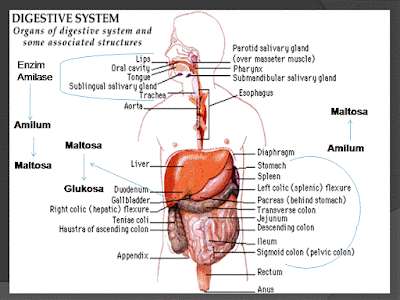Metabolism is the term used to
describe the interconversion of chemical compounds in the body, the pathways
taken by individual molecules, their interrelationships, and the mechanisms
that regulate the flow of metabolites through the pathways. Metabolic pathways
fall into three categories.
(1) Anabolic pathways, which are those involved in the synthesis of larger and more complex compounds from smaller precursors—for example, the synthesis of protein from amino acids and the synthesis of reserves of triacylglycerol and glycogen. Anabolic pathways are endothermic.
(2) Catabolic pathways, which are involved in the breakdown of larger molecules, commonly involving oxidative reactions; they are exothermic, producing reducing equivalents, and, mainly via the respiratory chain , ATP.
(3) Amphibolic pathways, which occur at the “crossroads” of metabolism, acting as links between the anabolic and catabolic pathways, for example, the citric acid cycle.
(1) Anabolic pathways, which are those involved in the synthesis of larger and more complex compounds from smaller precursors—for example, the synthesis of protein from amino acids and the synthesis of reserves of triacylglycerol and glycogen. Anabolic pathways are endothermic.
(2) Catabolic pathways, which are involved in the breakdown of larger molecules, commonly involving oxidative reactions; they are exothermic, producing reducing equivalents, and, mainly via the respiratory chain , ATP.
(3) Amphibolic pathways, which occur at the “crossroads” of metabolism, acting as links between the anabolic and catabolic pathways, for example, the citric acid cycle.
A 70-kg adult human being requires
about 8 to 12 MJ (1920-2900 kcal) from metabolic fuels each day, depending on
physical activity. Larger animals require less per kilogram body weight, and
smaller animals more. Growing children and animals have a proportionally higher
requirement to allow for the energy cost of growth. For human beings, this
energy requirement is met from carbohydrates (40%-60%), lipids (mainly triacylglycerol,
30%-40%), and protein (10%-15%), as well as alcohol. The mix of carbohydrate,
lipid, and protein being oxidized varies, depending on whether the subject is
in the fed or fasting state, and on the duration and intensity of physical
work.
There is a constant requirement for
metabolic fuels throughout the day; average physical activity increases
metabolic rate only by about 40% to 50% over the basal or resting metabolic
rate. However, most people consume their daily intake of metabolic fuels in two
or three meals, so there is a need to form reserves of carbohydrate (glycogen
in liver and muscle), lipid (triacylglycerol in adipose tissue), and labile
protein stores during the period following a meal, for use during the
intervening time when there is no intake of food.
If the intake of metabolic fuels is
consistently greater than energy expenditure, the surplus is stored, largely as
triacylglycerol in adipose tissue, leading to the development of obesity and
its associated health hazards. By contrast, if the intake of metabolic fuels is
consistently lower than energy expenditure, there are negligible reserves of
fat and carbohydrate, and amino acids arising from protein turnover are used
for energy-yielding metabolism rather than replacement protein synthesis,
leading to emaciation, wasting, and, eventually, death.
In the fed state, after a meal,
there is an ample supply of carbohydrate, and the metabolic fuel for most
tissues is glucose. In the fasting state, glucose must be spared for use by the
central nervous system (which is largely dependent on glucose) and the red
blood cells (which are wholly reliant on glucose). Therefore, tissues that can
use fuels other than glucose do so; muscle and liver oxidize fatty acids and
the liver synthesizes ketone bodies from fatty acids to export to muscle and
other tissues. As glycogen reserves become depleted, amino acids arising from
protein turnover are used for gluconeogenesis.
The formation and utilization of
reserves of triacylglycerol and glycogen, and the extent to which tissues take
up and oxidize glucose, are largely controlled by the hormones insulin and
glucagon. In diabetes mellitus, there is either impaired synthesis and
secretion of insulin (type I diabetes, sometimes called juvenile onset,
or insulin-dependent diabetes) or impaired sensitivity of tissues to insulin
action (type II
diabetes, sometimes called adult onset or noninsulin-dependent
diabetes), leading to severe metabolic derangement. In cattle, the demands of
heavy lactation can lead to ketosis, as can the demands of twin pregnancy in
sheep.

















0 komentar:
Posting Komentar